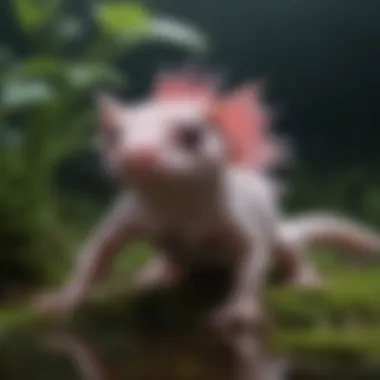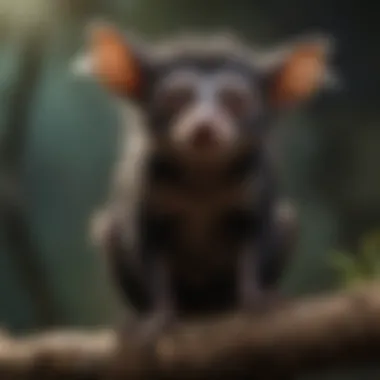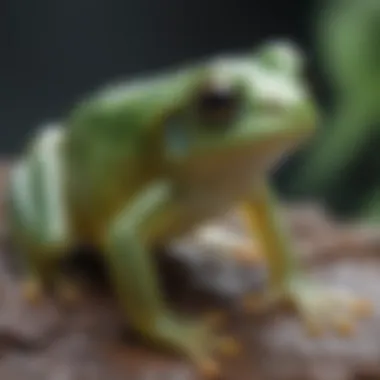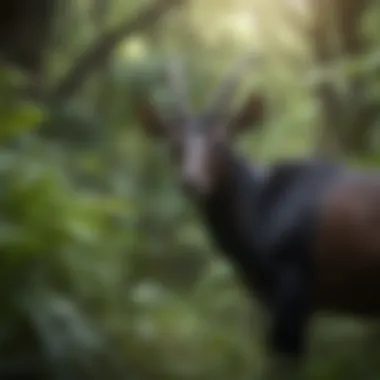Exploring Rare and Unusual Animals on Our Planet


Intro
The animal kingdom is full of mysteries and oddities, with each species offering a glimpse of nature's creativity. This article delves into rare and unusual animals, examining their traits, habitats, and the pressing need for conservation. By engaging with these exceptional species, we will uncover their ecological significance and promote awareness regarding biodiversity.
Animal Overview
Common Name and Scientific Classification
In this section, we examine various rare animals such as the Aye-Aye (Daubentonia madagascariensis) and the Saola (PseudoryxNghetinhensis). Understanding the common names along with their scientific classification provides insight into their unique evolutionary paths. This knowledge is essential for further research and conservation efforts.
Physical Characteristics
These animals possess extraordinary physical traits. For example, the Aye-Aye has long, slender fingers adapted for extracting insects from tree bark. Saola, on the other hand, has straight antlers and a striking face that distinguishes it from other bovids. Each animal's characteristics are not just interesting; they play crucial roles in their survival.
Habitat and Distribution
Rare animals inhabit a variety of environments. The Aye-Aye resides mainly in Madagascar’s rainforests, while the Saola is found in the Annamite Range of Vietnam and Laos. Understanding where these creatures live helps illustrate the diverse ecosystems they are part of and emphasizes the impact of habitat destruction.
Behavior and Social Structure
Communication Methods
Many unusual species possess unique ways of communicating. The Aye-Aye uses clicks and vocalizations to communicate with others in its environment. Similarly, the Saola is thought to utilize low-frequency sounds, further illustrating the diversity in animal communication.
Social Hierarchies
Social structures vary greatly among species. The Aye-Aye is mostly solitary, while the social dynamics of Saola remain largely unknown due to their elusive nature. Understanding these structures not only highlights their lifestyles but also reveals how social behaviors aid in survival.
Mating and Reproductive Behavior
Mating rituals can be equally diverse. Some rare animals display elaborate courtship behaviors, while others may have unique reproductive adaptations. Exploring these aspects assists in understanding their life cycles and the challenges they face in terms of reproduction in changing environments.
Conservation Status
Current Population Trends
The populations of many rare animals face decline due to numerous factors. For example, the Aye-Aye's numbers are decreasing primarily due to habitat loss. Protecting these animals entails understanding these trends clearly.
Threats and Challenges
Various threats endanger these species, including habitat destruction, poaching, and climate change. Understanding these challenges helps underscore the urgency of conservation efforts.
Conservation Efforts and Success Stories
There are ongoing conservation efforts aimed at protecting these rare animals. Organizations work to create protected areas, conduct research, and raise awareness. Success stories, such as the gradual recovery of certain populations due to conservation actions, inspire continued efforts in wildlife preservation.
Preserving biodiversity is not solely about saving individual species; it is about protecting the intricate web of life on our planet.
Prelude to Rare Animals
Rare animals represent a unique aspect of our planet's biodiversity. They often inhabit specific ecological niches and offer insights into environment’s health. These species may be limited in number, region, or both. Understanding rare animals is essential, as their existence often reflects broader environmental changes.
Understanding Rarity in Animal Species
Rarity in animal species can be understood through several lenses. First, it involves geographic distribution. Some species are naturally confined to small areas. For instance, the Ishikawa's Hummingbird is found only in specific locales, which limits its opportunities to thrive. Another aspect of rarity involves population size. Certain creatures may exist in such low numbers that they face immediate risks of extinction. This is true for the Kakapo, a flightless parrot with an extremely limited population. Finally, habitat specificity plays a pivotal role. Many rare animals depend on specific environments. Deforestation and climate change place immense pressure on these habitats, making it crucial to study and advocate for preservation.
Why Study Weird Animals?
Studying weird animals is vital for several reasons. First, these species provide a glimpse into evolutionary adaptations. Understanding their unique traits can shed light on evolutionary processes. Additionally, weird animals often play important roles in their ecosystems. For instance, the Deinosuchus, an ancient crocodilian, gives us insights into predator-prey dynamics in historical ecosystems.
The exploration of weird animals can also contribute to conservation efforts. Raising awareness about their precarious situations encourages action. It helps to cultivate a sense of responsibility among individuals and organizations. This is particularly important for species on the brink of extinction, such as the Saola. By studying and highlighting their stories, we can inspire urgent conservation measures that could protect their futures.
Studying rare and weird animals not only enhances our understanding of biodiversity but also underscores the importance of conservation in preserving the intricate web of life on Earth.
Criteria for Rarity
Rarity in animal species is a compelling topic that underscores the fragility of biodiversity on our planet. Understanding the criteria for rarity helps us identify which species are most vulnerable and at risk. This understanding directs conservation efforts effectively and sparks interest in unusual wildlife. The following subsections delve into fundamental factors that determine the rarity of animal species.


Geographic Distribution
Geographic distribution refers to the natural range where particular species can be found. Rare animals often inhabit restricted areas, making their populations more susceptible to external threats. For example, animals like the Kakapo are endemic to New Zealand and are confined to a few islands. Such limited range signifies vulnerability to habitat loss and changes in land use. Conservationists pay close attention to these animals because the loss of even a small percentage of their habitat can have catastrophic consequences.
Key points about Geographic Distribution:
- Limited range increases risk.
- Higher vulnerability to localized disasters.
- Importance of habitat preservation in conservation strategies.
Population Size
Population size is another crucial criterion when assessing rarity. A small population is often a strong indicator that a species is at risk. Low numbers can result from various factors including habitat destruction, poaching, or competition with invasive species. For example, the Saola is estimated to have fewer than 750 individuals left in the wild. Such low population figures raise alarms among biologists and conservationists, compelling them to initiate swift actions to protect these species from extinction.
Considerations regarding Population Size:
- Small populations are more prone to genetic problems.
- Difficulty in finding mates can affect reproduction.
- Monitoring population trends is vital for conservation assessments.
Habitat Specificity
Habitat specificity details how dependent a species is on particular types of environments. Some animals thrive in specialized habitats, making them vulnerable when those habitats are altered. For instance, the Ishikawa's Hummingbird primarily inhabits specific wetland areas. Changes in water levels or urban development can lead to significant declines in populations. Such specificity highlights the critical need for tailored conservation strategies that consider the unique needs of these animals.
Implications of Habitat Specificity:
- Specialized habitats need targeted conservation.
- Loss of habitat can result in rapid population declines.
- Awareness of specific requirements aids in effective conservation planning.
Examples of Weird Rare Animals
The study of weird rare animals is important not only for biodiversity but also for understanding various ecological systems. These species often hold keys to past environmental conditions and can offer insights into the future of ecosystems. The examination of lesser-known creatures brings attention to the broader needs of conservation efforts and the challenges these animals face.
By focusing on examples of unusual wildlife, we can appreciate the complexity of ecosystems and the subtle roles each species plays. This article will highlight a range of strange but fascinating species, each embodying unique traits that merit discussion.
The Aye-Aye of Madagascar
Unique Physical Features
The Aye-Aye stands out among the primates due to its peculiar physical traits. Its elongated middle finger is a fascinating adaptation for foraging. This unique feature allows it to tap on tree bark and locate grubs underneath. Such behavior contributes to the Aye-Aye's ecological role as a pest controller, which can be seen as a beneficial aspect for overall forest health. Moreover, the distinct appearance of the Aye-Aye serves as an effective choice for this article, emphasizing the importance of biodiversity.
Behavioral Traits
The nocturnal behavior of the Aye-Aye provides insight into its survival strategies. It employs echolocation, a unique trait that enhances its hunting capabilities in dark environments. This method of locating prey highlights the complexity of its ecological interactions. Knowing how the Aye-Aye behaves can encourage awareness of nocturnal wildlife and their ecological significance.
Conservation Status
The Aye-Aye faces significant threats due to habitat loss and superstition in local cultures. Understanding its conservation status is crucial. The recognition of this species' endangered classification emphasizes the urgent need for targeted conservation strategies. Highlighting this aspect enhances the overall goal of promoting awareness for rare species.
The Saola: Asia's Unicorn
Discovery and Habitat
The discovery of the Saola in 1992 was a remarkable event in wildlife biology. This species thrives in dense forests of Vietnam and Laos, highlighting the richness of Southeast Asia's biodiversity. Its existence suggests that there are still undiscovered species on our planet, which can inspire further exploration. This aspect is significant for demonstrating how much we still have to learn about our world's biodiversity.
Physical Appearance
The Saola's striking physical characteristics, including long straight horns and a unique facial structure, make it an intriguing subject. Its appealing appearance makes it popular among conservationists and nature lovers, who seek to protect its habitat. The Saola thus represents the delicate beauty of rare species.
Threats and Conservation Efforts
This species faces severe threats such as deforestation and poaching. Awareness of these challenges is vital to creating effective conservation plans. Ongoing efforts to conserve the Saola highlight the importance of community involvement in preserving this rare animal. Such initiatives can inspire a collective responsibility towards animal conservation.
The Kakapo: A Parrot on the Brink
Flightless Nature
The Kakapo's flightless nature is both a curse and a blessing. While it makes the species more vulnerable to predators, it has also led to a specialized ecological niche. This unique trait makes them interesting research subjects, providing insight into the evolution of flightlessness in birds. The advantages of this feature can be analyzed to understand adaptive strategies in birds.
Breeding Programs
Significant efforts are underway for Kakapo breeding programs, highlighting conservation successes. These programs employ advanced techniques to increase population size and genetic diversity. By sharing successful breeding stories, the hope is to inspire similar efforts for other endangered species.


Ecological Role
Kakapos play a crucial role in their ecosystem by helping with seed dispersal. This interaction is essential for maintaining healthy vegetation, linking their survival to the overall health of their habitats. Recognizing their ecological contributions underscores the broader significance of preserving the Kakapo and similar species.
The Deinosuchus: The Giant Crocodile
Fossil Record Insights
The Deinosuchus offers invaluable insights into prehistoric ecosystems through its fossil records. This ancient crocodile provides clues about past climates and environmental conditions, helping to understand the evolution of modern crocodilians. The advantage of studying such fossils extends to broader ecological implications as well.
Ecological Impacts
As apex predators, Deinosuchus played significant roles in their habitats, regulating other species' populations. This impact can provide lessons on the importance of predator-prey dynamics, a crucial aspect of ecological balance. Understanding these interactions can foster new conservation strategies.
Implications for Modern Conservation
Examining Deinosuchus allows modern wildlife biologists to appreciate the evolutionary history leading to current species. The implications for contemporary conservation are profound, as they emphasize lessons learned from past extinctions and biodiversity loss. Highlighting such connections fosters a deeper understanding of why conservation efforts are critical.
The Ishikawa's Hummingbird
Uncommon Characteristics
The Ishikawa's hummingbird is distinctive for its bright plumage and unique calls. These traits make it crucial for attracting mates and maintaining social structures. Examining this species adds to the understanding of bird communication and the ecological significance of pollinators.
Migration Patterns
This species migrates over significant distances, showcasing its resilience and adaptability. Understanding its migratory patterns offers insights into how environmental changes impact avian populations. Such knowledge deepens our appreciation of the challenges faced by migratory birds.
Conservation Efforts
The need for conservation efforts targeting the Ishikawa's hummingbird is critical. Focused initiatives can ensure sustainable habitats and contribute to the preservation of unique avian species. The recognition of such efforts can motivate further action towards protecting similar species.
The Role of Biodiversity
Biodiversity is a crucial factor in the survival of life on Earth. Its role extends beyond mere variety of species to encompass ecosystem functions and the resilience of our natural environments. By exploring the role of biodiversity, we can appreciate how it shapes the survival and interaction of rare and weird animals with their surroundings. Recognizing the benefits of biodiversity is essential for understanding environmental health.
Ecosystem Stability
Ecosystem stability can be defined as the ability of an ecosystem to maintain its ecological processes and functions despite external stressors. A diverse set of species contributes to this stability in several ways:
- Resilience to Change: Biodiverse ecosystems can adapt better to changes, such as climate fluctuations or natural disasters. Multiple species fulfilling similar roles can ensure that the ecosystem continues to function even when some species decline.
- Nutrient Cycling: Various species play unique roles in nutrient cycling. Different plants, animals, and microorganisms contribute to soil fertility, which is crucial for the growth of vegetation that supports entire food webs.
- Pest and Disease Regulation: A stable ecosystem with high diversity naturally regulates pest populations and disease transmission. Various animals and insects can curb the spread of harmful species, thus maintaining the balance within the ecosystem.
Understanding the importance of ecosystem stability provides context for the conservation of weird and rare animals, which often exist in fragile systems.
Interdependence of Species
Interdependence refers to the way different species rely on one another for survival. This interconnectedness is vital in maintaining ecosystem functions. Here are key aspects of this interdependence:
- Food Web Dynamics: Each species occupies a specific niche within its ecosystem. Predators, prey, and decomposers all rely on each other to maintain a balanced food web. If a rare animal goes extinct, it might have far-reaching impacts on other species within that food web.
- Pollination: Many plants depend on specific animals for pollination. If these animals, like the Ishikawa's Hummingbird, face population declines, it threatens both plant reproduction and, consequently, the entire ecosystem.
- Habitat Provision: Some species create habitats for others. For example, dead trees provide essential nesting sites for birds and insects, demonstrating that the role of one species can greatly enhance the survival of many others.
The interconnectedness of all species illustrates that protecting biodiversity safeguards the stability of ecosystems vital for life.
By recognizing the intricacies of ecosystem stability and species interdependence, we underscore the need for comprehensive conservation strategies. Ensuring protection for rare animals is not just an ethical imperative; it is essential for the health of our planet.
Conservation Challenges
Conservation challenges are vital to understanding the plight of rare and weird animals. These challenges arise from various anthropogenic factors that threaten the survival of these species. Addressing these issues is crucial for effective conservation strategies and maintaining biodiversity. Awareness of these challenges not only informs the public but also inspires action towards preserving fragile ecosystems.
Threats from Habitat Loss
Habitat loss is a primary threat facing many rare animals. As human activities expand—such as urbanization, agriculture, and logging—natural habitats are converted or destroyed. This leads to fragmentation of the remaining habitats, making it difficult for species to thrive. Animals like the Aye-Aye in Madagascar suffer from loss of native forests, which is critical for their survival and reproduction.
Key points on habitat loss:
- Reduction of Living Space: Many species, including the Kakapo, require specific environments to live. When their habitat shrinks, their populations decline.
- Increased Competition: As habitats diminish, the competition for limited resources intensifies. This can impact weaker species disproportionately.
- Loss of Biodiversity: The removal of certain species disrupts ecological balance. This is evident in regions facing deforestation.
Impact of Climate Change


Climate change poses significant risks to rare animals, exacerbating existing threats. Species like the Saola are particularly vulnerable to changing climates. As temperatures rise, their habitats may shift or disappear altogether. Additionally, climate change can alter food availability and breeding patterns, leading to decreased populations.
Effects of climate change include:
- Shifts in Habitat Range: Many species are forced to migrate to cooler areas, which may not always be viable or suitable. This can lead to population declines.
- Impact on Food Sources: Changes in climate can affect the availability of prey or plants. An example is the impact on specific flowering patterns that hummingbirds rely on for nectar.
- Increased Natural Disasters: Events like floods and droughts can decimate small populations quickly, contributing to more rapid extinctions.
Poaching and Illegal Trade
Poaching and illegal trade are pressing issues that directly threaten the survival of rare animals. The demand for exotic pets, traditional medicine, and luxury goods leads to unsustainable hunting practices. Animals such as the Ishikawa's Hummingbird suffer from trapping and illegal sales. This further compounds the challenges they face.
The consequences of poaching include:
- Population Decline: Targeting rare species for illegal trade rapidly decreases their numbers. It can take generations of low population growth to recover.
- Disruption of Social Structures: Many species rely on established social structures for procreation and survival. Removing individuals from their groups can lead to long-lasting effects.
- Economic Incentives for Illegal Activities: Regions with high poverty are more susceptible to poaching. This economic motivation complicates conservation efforts, as locals may rely on income from poaching.
Conservation Efforts and Strategies
Conservation of rare and unusual animals is crucial not only for their survival but also for the ecosystem's overall health. As we delve into the challenges faced by these animals, the need for effective strategies becomes evident. These efforts serve multiple purposes, from habitat protection to legislation and community engagement. Their importance cannot be overstated.
Protected Areas and Habitats
Protected areas play a vital role in safeguarding rare animal species. These designated regions are designed to conserve the natural environment and the species that inhabit it. By ensuring that these areas are free from human interference, we provide a sanctuary for the unique creatures that might otherwise face extinction.
In addition, through establishing wildlife reserves and national parks, we can maintain ecosystems that support these animals. These habitats must be managed effectively to promote biodiversity. This involves not just setting boundaries but also monitoring and researching species within these protected environments.
Some key benefits of protected areas include:
- Preservation of Biodiversity: Maintaining a diverse range of habitats is essential for the survival of many species.
- Scientific Research: Protected areas offer unique opportunities for research, helping us to understand species behavior and ecology better.
- Ecotourism: By protecting these areas, we can promote sustainable tourism that helps fund conservation efforts.
Legislation and Legal Framework
Effective legislation is essential to create a robust legal framework for the conservation of rare animals. Laws that protect endangered species from poaching and habitat destruction are crucial. The Endangered Species Act, for example, provides government protection to various animal species facing extinction.
Legal protections can help ensure that habitats are safeguarded, and illegal activities are deterred. Furthermore, international agreements such as the Convention on International Trade in Endangered Species of Wild Fauna and Flora (CITES) provide a global platform to regulate the trade of endangered species.
Key components of effective legislation include:
- Strict Penalties for Poaching: Deterring illegal hunting helps protect vulnerable populations.
- Monitoring Compliance: Governments must ensure that laws are enforced and monitored effectively.
- International Cooperation: Many rare animals are found in multiple countries, necessitating cross-border collaboration.
Community Involvement
Community engagement is vital for successful conservation initiatives. Conservation efforts gain strength when local communities are involved. Education and awareness programs can inform people about the importance of preserving rare species.
Moreover, local populations often possess valuable knowledge of their environment, which can be utilized in conservation strategies. By involving the community, we can foster a sense of ownership and responsibility towards wildlife and their habitats.
Ways to promote community involvement include:
- Educational Workshops: Teach communities about the ecological roles of rare animals.
- Collaborative Conservation Projects: Partner with locals to implement conservation plans.
- Volunteering Opportunities: Encourage people to participate in conservation efforts whether through clean-up projects or wildlife monitoring.
Conservation is not just about protecting species; it is about engaging communities to foster a sustainable relationship with nature.
In summary, conservation efforts and strategies are paramount for the survival of rare and uncommon animals. It requires a multifaceted approach that combines protected areas, legal protections, and active community participation. By addressing these aspects, we not only benefit these unique species but also improve the overall health of our ecosystems.
The End
In the exploration of rare and unusual animals, the role of awareness stands as a cornerstone. Recognizing the characteristics and struggles of these species is not just an academic exercise. It shapes how societies value wildlife and influences conservation efforts. Understanding the complexities of their existence fosters empathy and responsibility towards biodiversity. When awareness increases, so does the inclination to protect these unique creatures.
The Importance of Awareness
Awareness regarding rare animals leads to several critical benefits. Firstly, it highlights the ecological significance of these species. Each animal, no matter how obscure, plays a role in its ecosystem. For instance, the Kakapo's unique behaviors can affect seed dispersal patterns of particular plant species, which in turn supports other wildlife.
Increased awareness can also drive scientific research. When more people understand and appreciate these animals, it can stimulate funding for studies and conservation projects. Knowledge helps them to become ambassadors for their own kind.
Moreover, awareness creates a platform for education. It is crucial for future generations to learn about the diversity of life on Earth. Schools, universities, and community organizations can educate young minds about the significance of wildlife preservation. When fueled with knowledge, individuals can channel their efforts toward active conservation strategies. As a direct result, they engage with nature positively.
Call to Action for Conservation
A call to action is vital for the conservation of rare species. Individuals and organizations must champion protective measures targeted at these animals. Simple measures can include supporting local conservation initiatives. Volunteering for wildlife sanctuaries, donating to relevant causes, or even participating in citizen science programs can usher significant change.
At a larger scale, advocacy for legislative reforms is crucial. Policymakers need to hear voices urging the enhancement of laws protecting endangered species. Engaging with legislative bodies to encourage stricter regulations against poaching and habitat destruction can yield meaningful improvements.
Communities also have a role in conservation efforts. Engaging local populations in sustainable practices strengthens the bonds between humans and wildlife. This ensures a shared responsibility towards protecting the environment.
"Effective conservation requires both awareness and action. Knowledge without application falls short."







